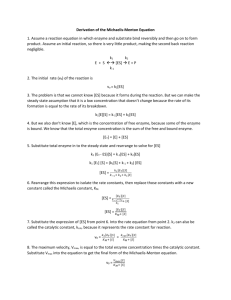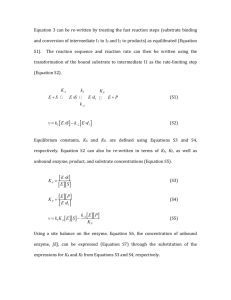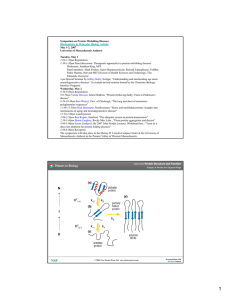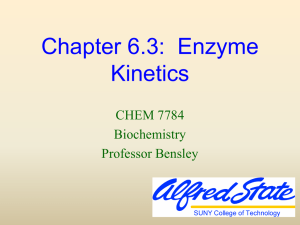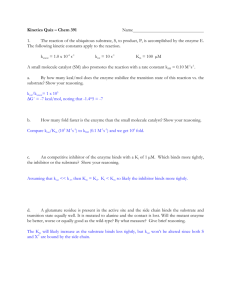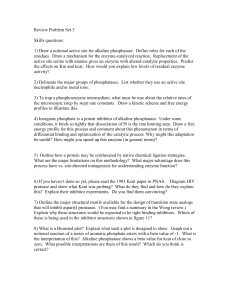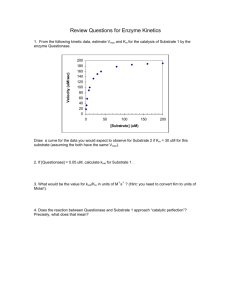Power Point
advertisement
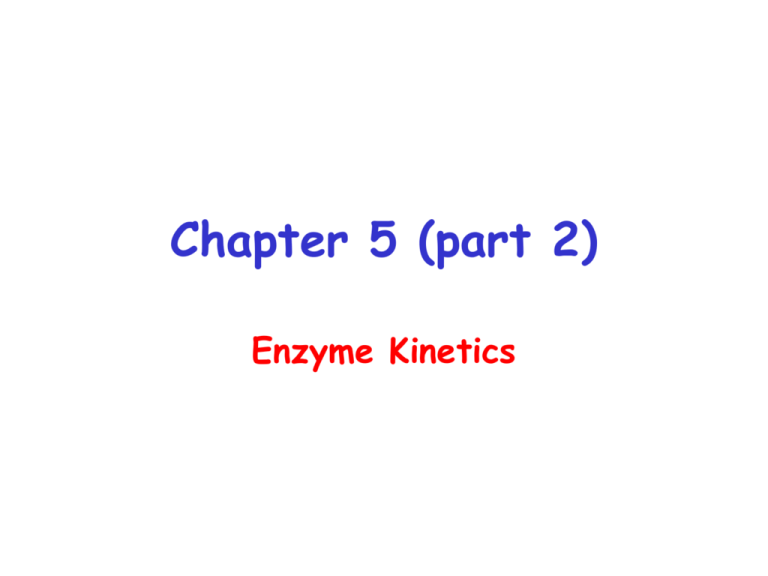
Chapter 5 (part 2) Enzyme Kinetics Rate constants and reaction order Rate constant (k) measures how rapidly a rxn occurs A k1 k-1 B + C Rate (v, velocity) = (rate constant) (concentration of reactants) v= k1 [A] 1st order rxn (rate dependent on concentration of 1 reactant) v= k-1[B][C] 2nd order rxn (rate dependent on concentration of 2 reactants) Zero order rxn (rate is independent of reactant concentration) E E S + S E+S k1 k-1 ES E k2 k-2 E+P + P Initial Velocities Hold [E] constant [E]<<<<<[S] [P] D[P]/DT = Vo1 mM [S] = 1 mM time Initial Velocities D[P]/DT = Vo10 mM [P] D[P]/DT = Vo5 mM [S] = 10 mM [S] = 5 mM D[P]/DT = Vo1 mM [S] = 1 mM time Plot Vo vs. [S] Vo 10 mM Vo Vo 1 mM 5 mM • Michaelis-Menton Equation • Describes rectangular hyperbolic plot • Vo = Vmax [S] Km + [S] Vmax = velocity where all of the enzyme is bound to substrate (enzyme is saturated with S) Km = [S] @ ½ Vmax (units moles/L=M) (1/2 of enzyme bound to S) Initial Velocity Assumption 1) Measurements made to measure initial velocity (vo). At vo very little product formed. Therefore, the rate at which E + P react to form ES is negligible and k-2 is 0. Therefore E E S + S E+S k1 k-1 ES E k2 k-2 E+P + P Data from a single experiment performed with at a single [S]. (single point on Vo vs. [S] plot) Initial Velocities D[P]/DT = Vo10 mM [P] D[P]/DT = Vo5 mM [S] = 10 mM [S] = 5 mM D[P]/DT = Vo1 mM [S] = 1 mM time Steady State Assumption Steady state Assumption = [ES] is constant. The rate of ES formation equals the rate of ES breakdown E E S + S E+S k1 k-1 ES E k2 E+P + P Rate of ES formation E E S + S E+S k1 ES Rate = k1 [E] [S] Rate of ES breakdown E S ES E k2 ES k-1 P E+P E E S + + S E+S Rate = (k2 [ES]) + (k-1[ES]) Rate = [ES](k2 + k-1) Therefore………if the rate of ES formation equals the rate of ES breakdown 1) k1[E][S] = [ES](k-1+ k2) 2) (k-1+ k2) / k1 = [E][S] / [ES] 3) (k-1+ k2) / k1 = Km (Michaelis constant) What does Km mean? 1. Km = [S] at ½ Vmax 2. Km is a combination of rate constants describing the formation and breakdown of the ES complex 3. Km is usually a little higher than the physiological [S] What does Km mean? 4. Km represents the amount of substrate required to bind ½ of the available enzyme (binding constant of the enzyme for substrate) 5. Km can be used to evaluate the specificity of an enzyme for a substrate (if obeys M-M) 6. Small Km means tight binding; high Km means weak binding Hexose Kinase Glucose + ATP <-> Glucose-6-P + ADP Glucose Allose Mannose Km = 8 X 10-6 Km = 8 X 10-3 Km = 5 X 10-6 What does kcat mean? 1. kcat is the 1st order rate constant describing ES E+P 2. Also known as the turnover # because it describes the number of rxns a molecule of enzyme can catalyze per second under optimal condition. 3. Most enzyme have kcat values between 102 and 103 s-1 4. For simple reactions k2 = kcat , for multistep rxns kcat = rate limiting step E+S k1 k-1 ES kcat E+P What does kcat/Km mean? • It measures how the enzyme performs when S is low • kcat/Km describes an enzymes preference for different substrates = specificity constant • The upper limit for kcat/Km is the diffusion limit - the rate at which E and S diffuse together (108 to 109 m-1 s-1) • Catalytic perfection when kcat/Km = diffusion rate • More physiological than kcat Limitations of M-M 1. Some enzyme catalyzed rxns show more complex behavior E + S<->ES<->EZ<->EP<-> E + P With M-M can look only at rate limiting step 2. Often more than one substrate E+S1<->ES1+S2<->ES1S2<->EP1P2<-> EP2+P1<-> E+P2 Must optimize one substrate then calculate kinetic parameters for the other 3. Assumes k-2 = 0 4. Assume steady state conditions
